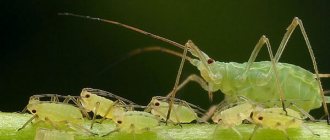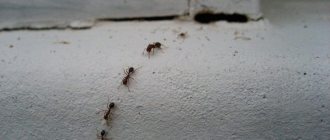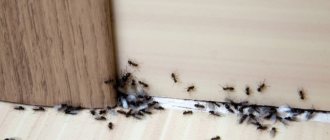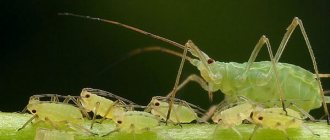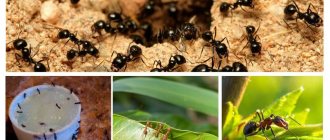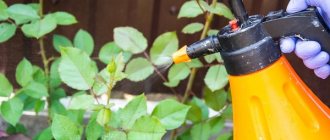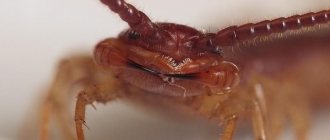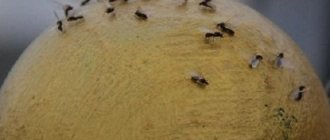Ants (in Latin Formicidae) belong to the order Hymenoptera. These social insects make up three castes - males, females, and working individuals, which together form a family (colony). Such colonies usually live in anthills, which are located: in wood, in the soil and on the surface of the earth, under stones and in other places adapted for their life. Some species live in human homes.
When these insects spread en masse in a dacha, it is necessary to take effective measures to get rid of ants on the site once and for all. Otherwise, they can bring certain inconvenience and even harm to a person and his land.
Ants on the site: benefits and harm
It sounds a little strange, but ants can also provide benefits to summer cottages, since they feed not only on plant sap and sweet liquid - honeydew, which is secreted by aphids, but also on the larvae of harmful insects, thereby regulating their numbers in the garden. These insects also perform other useful functions. For example, they loosen the soil, increasing its aeration. This contributes to a significant improvement in its quality.
Female black ants have wings and a slightly enlarged abdomen
We can talk about harm when ants breeding in large numbers cause serious damage:
- By settling in country houses and outbuildings, they render food supplies unusable;
- It is harmful if ants help spread aphids, which have a detrimental effect on plants;
- Some ants spread viral and bacterial diseases that are dangerous to humans;
- In places where underground anthills are located, the acidity of the soil increases, which adversely affects the development of plants;
- When insects settle in garden beds, the growth of planted vegetable crops is inhibited;
- Massive colonies often use ripe berries, vegetables and fruits with a high concentration of sugar for food, and gnaw out the buds of roses and peonies;
- They spread weed seeds throughout the area.
For reference! Mainly, red, black and yellow species of ants are found in home areas. Despite the fact that these insects can be fought in different ways, it is almost impossible to completely get rid of ants in the country. We are talking only about a significant reduction in their population.
The colony of earth ants on the site numbers from 10 to 50 thousand individuals
What to do if folk remedies do not work?
If there is no effect from using folk remedies (this happens with a very heavy insect invasion), you will have to resort to store-bought drugs, that is, insecticides. They are produced in different types:
- aerosol - very convenient to use in apartment conditions (only working individuals die);
- solution - useful in vegetable gardens, no need to dilute;
- powder - universal, crumbles and dilutes in water;
- granular form—for home, garden (a big advantage is that harmful substances do not enter the respiratory system);
- gel - convenient, effective for placement (ants will bring it to the uterus);
- pencil—acts like a powder, convenient to apply to walls;
- repeller - an ultrasonic device, a device operating from mains or batteries (not harmful to people);
- trap - a device containing gel, glued to the wall.
When using folk remedies, focus on those that do not kill insects instantly. We must give them the opportunity to carry poisoned food to the nest. When dealing with garden pests, consider the proportion of pests to vegetation and soil. Chemicals are a last resort.
Plants that repel ants
To get rid of ants in your dacha once and for all, it is recommended to use plants whose pungent odor repels these insects. To do this, nasturtium, mustard, parsley, and dill are planted around the perimeter of the site. Lavender, marigolds, and mustard are placed between the rows of the beds and around the flower beds.
Insects cannot tolerate the smell of tansy, lemon balm, and fennel. Rosemary, cilantro, potatoes, and anise will scare them away. Mint and valerian are planted in tree trunk circles to protect trees. Dried plants like these are laid out in secluded places in houses and various buildings.
Plants that repel ants - effectively help get rid of them once and for all
How to fight in a private house
In a private home, the appearance of ants will be a big problem.
Folk remedies will help get rid of annoying parasites.
Instructions
- First, find the place where the redheads entered your home.
- Seal the holes with sealant or putty.
- Follow the trails to their house.
- If the queen is outside the house, this will make it easier to destroy the colony.
- Pour boiling water inside.
- After 30 min. a solution of vinegar and oil with water, in a ratio of 1:1:2.
- Wash the floor indoors with vinegar and camphor.
- Wipe baseboards and window sills with vinegar; the smell repels parasites.
- Place cotton wool with aromatic oils (mint, citrus) throughout the house.
- For a week, keep your kitchen clean and wipe down your house with vinegar.
Repeat the process from the beginning after 7 days.
Video instruction
Traditional methods of fighting ants
You can effectively fight ants using traditional methods. For example, to eliminate ants from the site, summer residents and gardeners use food additives and other substances with a pungent odor that is unpleasant for insects.
- Essential oils . The list of aromatic oils that are recommended to be included in the arsenal of products that do not allow insects to spread excessively is quite extensive. Anise, juniper, and lavender are most often used. Cinnamon, cedar, and mint show good results. It is necessary to treat door, ventilation and window openings, and apply a small amount along the baseboards. This technique will not only expel annoying insects from your home, but will also serve as a preventive measure against their invasion.
- Onion and garlic . These vegetable crops with a characteristic odor help drive ants out of their favorite places and keep them away from plants or buildings. Rub cut garlic cloves on the threshold of the house and tree trunks. Place chopped onion and garlic slices inside the home, on ant paths, around the perimeter of anthills.
- Vinegar . A solution of table vinegar (5%) is used to irrigate the surface of the soil around the cabbage and treat the ant trails. If insects are noticed in the house, it is recommended to wipe the floors, door frames, and benches with vinegar. Spray greenhouses and hotbeds if necessary.
- Coffee . Collect grounds from freshly brewed natural coffee. Place it under bushes of blooming peonies and roses. You can scatter it over the surface of an anthill found in the soil, or spread it under strawberry leaves.
Other repellents
Ants are afraid of the smell of many substances that summer residents sprinkle on beds, paths, row spacing, the perimeter of greenhouses and hotbeds, the threshold of houses, tree trunk circles:
- ground red pepper;
- cinnamon;
- tobacco dust;
- a mixture of equal parts of wood dust, ash, lime;
- lemon or orange peels soaked in water for 24 hours.
Advice! You can treat them with unrefined sunflower oil or sprinkle their habitat with wood ash. When it sticks to the paws, the insects experience a burning sensation and rush to leave the treated areas.
Acetic acid as an alternative to vinegar
Are ants afraid of acetic acid? Acid will drive away and destroy ant colonies faster than table vinegar.
Author's note
Kirilova Olga
Be careful when using acid. Inhalation of vapors is harmful to the respiratory tract. Acid contacting the skin causes burns.
Proportions
Use the acid in diluted form:
- 1 part essence + 3 parts water.
- 1 part acid + 2 parts water.
Usage
- Fill the mixture into a spray bottle.
- Spray the redheads on the paths, so they will spread the smell on themselves. They themselves will die and others will be driven away.
- Treat the settlement together with the queen.
- Cover the anthill with film.
- Repeat spraying after 2 days.
Gentle folk methods of fighting ants
The popularity of folk wisdom remedies is explained by their relative safety for ants, since they are mainly aimed at eviction rather than destruction of their populations. The most humane way is to relocate the entire anthill to the nearest forest.
- The discovered nest is dug up from all sides in the evening and then transferred to a bucket or bag. All that remains is to move it to the chosen place away from the summer cottage.
- It also does not harm insects, forcing them to leave their habitable nests, by arranging shields over them that create dense shadow. Since ants choose sunny places for their houses, constant shading will serve as a signal for them to move.
- It makes it necessary to leave the nest by watering anthills with a solution of a glass of jam mixed in a bucket of water. After such treatment, the development of yeast fungi intensifies, infecting the food supplies of ants.
- For the same purpose, dissolve 250 ml of ammonia with a concentration of 10% in five liters of water. Ants are forced to leave the house by an unpleasant aroma.
Fighting ants with humane methods - involves the use of repellent rather than insect-killing agents
Essential oils against pests
There is a special advantage in using essential oils: their aroma does not fade over a long period and spreads over a large area. There is a contraindication for use - allergies. It is unacceptable to use if there are infants and small children of two or three years old in the house.
Active oils:
- orange;
- eucalyptus;
- mint;
- juniper;
- fir;
- needles.
How to use it correctly:
- mix with water, spray the floor;
- leave the container with oil open;
- light incense sticks.
Methods for destroying anthills
If it is not possible to scare off the ants, and they occupy more and more territory in the summer cottage, they resort to more serious methods of destroying the discovered nests.
- Using boiling water . In the evening, when the workers return to their nests, heat the water to boiling and water the discovered anthills, using a bucket for each. After the destruction of the nesting site, the death of the queen and most insects, the remaining individuals leave their usual place.
- Tomato tops . Fresh tomato stems and foliage are crushed. Measure out 2 kg of raw materials and place them in a pan with 10 liters of boiling water. Leave for 48 hours in a sunny place to infuse. The finished infusion is filtered through cheesecloth. Dissolve 30 g of green soap shavings in the resulting volume. Pour the liquid into the anthill. Insects die quite quickly.
- Fire . Some offer radical methods that require caution from the person performing the actions. Douse ant nests with gasoline or kerosene and throw a lighted match, moving away to a safe distance.
There are other methods to ensure the destruction of insects
- Dissolve 1 tbsp in a liter of water. l. kerosene and fill the ant house.
- Combine shampoo with vegetable oil - 400 ml each. While stirring, pour in water - 200 ml and table vinegar (6%) - 250 ml. They spill ant nests.
- Once a week, pour a mixture of carbolic acid dissolved in 10 liters of water into the discovered anthills - 2 tbsp. l., powdered laundry soap - 400 g and kerosene - 10 tbsp. l.
- Baking soda, which is generously sprinkled on ant nests in dry weather, has a detrimental effect. To enhance the effect, add powdered sugar in equal parts to the baking soda.
- You can dissolve 2 tbsp. l. soda in 1.5 liters of water. After thorough kneading, spill the anthill. Dry soil is placed on top and the nest is covered tightly with plastic film, blocking the flow of oxygen, which is reinforced with boards or stones.
- It is recommended to sprinkle millet or semolina. When eaten, it swells and causes the death of insects. To lure, mix cereal with sugar.
Black ants are considered the most dangerous pests for gardens and vegetable gardens.
How to use in the bath
Treating the walls with preparations against mold and mildew will help prevent the appearance of redheads in a wooden bathhouse. Plant mint bushes around the building; ants do not like its smell.
If you notice uninvited guests in the dressing room, start by searching for their habitat.
Destroying the anthill is an effective way to remove them. Ants cannot live without their queen.
Scald all walls and floors with boiling water. Treat with a mixture of vinegar and water.
Instructions
- Prepare a solution of water and vinegar (1:1).
- Place in a spray bottle.
- Walk around the entire perimeter of the bathhouse.
- After 2 days, wash the walls and floor with laundry soap.
- Dry and ventilate by opening the door.
If necessary, repeat the process.
Poison baits
Installing poisonous baits with an attractive aroma or taste in places where insects move and gather in large numbers can significantly reduce their numbers. For this purpose, liquid preparations are prepared and poured into low, small containers. They are fixed under plants, on paths, around anthills.
Effective recipes
- Stir fine granulated sugar - 2 tbsp. l. in 100 ml of water with the addition of a bag of powdered boric acid.
- Dissolve sugar - 2 tbsp. l. in 100 ml of hot water. After cooling, dilute a teaspoon of powdered poisonous drug against ants in syrup.
- Dissolve in 15 tbsp. l. water 5 tbsp. l. sugar and 2 tsp. Boers. Heat the mixture while stirring. When the sugar grains have melted, remove from heat and cool. Enter 5 tsp. honey After kneading, the composition is ready for use.
Starch
The principle of action of this substance is approximately the same as that of semolina. But no one will eat it just like that. But don’t despair - you just need to pour starch near the place where insects accumulate, and place a container with bait in the center - a spoonful of honey, jam, syrup. Then he will definitely stick to the paws of all the individuals making their way to the treat. While cleaning it, the ant will swallow a sufficient amount and take the remains to the colony, thus poisoning its fellow tribesmen.
Ant Traps
The purpose of setting traps is to attract insects. They fall into the liquid or viscous mass prepared for them and cannot get out. All that remains is to collect the low jars filled with ants and prepare a fresh portion, focusing on simple recipes:
- Place 2 tbsp in a jar. l. fresh yeast. Add water and stir vigorously until a slurry with the consistency of kefir is formed. Additionally, add 2 tsp. jam or jam and grind the mass until smooth.
- Making a honey trap is even easier and faster. To make it, dilute 1.5 tsp in 300 ml of water. honey You can make sugar syrup or stir jam in water.
You can use regular lump sugar as a sweet bait for ants.
Chemicals
If it is impossible to reduce the ant population that has spread throughout the dacha area, they resort to special chemicals. Among them are the following popular options:
| Ant-eater | Produced in liquid and powder form. The active ingredient is the powerful insecticide diazinon. |
| Muratsid | An effective and inexpensive drug has a detrimental effect on larvae and adults. |
| Grom-2 | Available in granules, maintaining its effect for a month. |
| Expel | The powder is scattered in places where mass concentrations of ants are detected or irrigation solutions are prepared in accordance with the instructions. |
Important! During work, safety measures are observed, including respiratory protection with a gauze mask and hands with gloves.
Vegetation for removing ants
This method is considered gentle and consists of using fresh and dry vegetation, this includes seasonings and spices.
Ants don't like:
- mint, parsley, lavender, chamomile - plants are hung in the room or laid out in areas where insects hunt;
- anise, bay leaf, cloves, hot peppers - putting these seasonings in cloth bags, hang closer to the floor surface;
- garlic - cut the cloves in half, place them throughout the room, or lubricate the insect paths with juice;
- lemon—use similar to the previous one;
- geranium - growing indoor plants on windowsills.
Protection of trees and shrubs
- Experienced gardeners have devices in their arsenal that allow them to protect trees from ants. To do this, a cut car tire is placed around the trunk. The cut is located on top, which creates a groove that, after filling with water, insects will not be able to overcome. Strips of foil are attached to the trunks in several tiers, which are twisted into a cone and the top edge is folded back.
- It is recommended to whitewash trees in spring and autumn. It will protect against insects with tar, which is applied to the trunk with a strip made in the form of a ring. Ants will not be able to overcome the viscous mass. A strip of roofing material plays a similar role. The barrel is wrapped with it, and a long-drying adhesive substance is smeared on top. You can wrap it with double-sided tape, removing the top protective layer.
- They are tied to the stems and laid out on the surface of the soil: bunches of garlic, wormwood, tansy. The shoots of raspberries, blackberries, and currants are tied, retreating 15 cm from the ground, with narrow strips of sheepskin soaked in carbolic acid, with the wool facing out.
- To destroy already settled goosebumps, combine kerosene - 120 ml, tar soap ground into powder - 400 g, formic acid - 20 g. Pour the mixture with 10 liters of water while vigorously stirring. Shrubs and trees are irrigated every three days. A total of five treatments will be needed.
Measures to protect tree trunks and branches from ants
The appearance of ants in your summer cottage will not cause significant damage if you promptly begin using proven methods to repel and destroy them. It is important to prevent strong reproduction of aphids, remove plant debris, dig up the soil after harvesting, and protect the area with plants that repel insects.
Author of the article: Kamenkov Igor Dmitrievich
- Related Posts
- How to treat cabbage against pests - folk remedies, effective methods of insect control
- Planting onions before winter is the key to a healthy and rich harvest with minimal losses
- Valerian will help against cabbage pests: tested by myself
« Previous entry
Ammonia, vinegar and other means
Pharmaceutical products are also very widely used to resist pests, for example, ammonia - ants cannot tolerate it.
Preparation and use:
- Pour a bottle of product (100 ml) into a liter of water.
- Treat surfaces on which insects run.
- Wash the floor surface.
Ammonia has a rather pungent odor. The presence of children, allergy sufferers and animals is unacceptable in the room where processing is carried out. It is imperative to use a respirator. The "aroma" usually dissipates after 25-35 minutes.
Other means:
- Soak a cloth in vinegar and wipe the baseboards, flooring, legs of furniture, walls, and trash cans.
- Apply Vaseline to the entrances through which insects enter the room.
- Place the tobacco from one cigarette in a glass of water, let it sit for 24 hours, add two to four drops of iodine, and spray around the room.
- Use chalk to mark “barriers” through which insects will not crawl.
Why is an ant invasion dangerous?
Ants spoil food and take food around the house, contributing to the appearance of mold. They may “kindly” bring to you the eggs of worms or aphids. Being regulars in garbage cans, they spread germs, including dangerous ones. Ants also bite, which affects both people and pets. Moreover, an ant bite is not only painful, but can also cause itching, allergies and even a viral infection.
Ants can contribute to mold in your home
